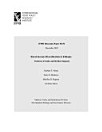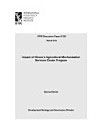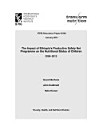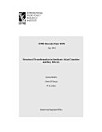Agricultural intensification in Ethiopia: Patterns, trends, and welfare impacts
Berhane, Guush · Abate, Gashaw Tadesse · Wolle, Abdulazize
ডিচে ২০২২ · IFPRI Discussion Paper কিতাপ 2150 · Intl Food Policy Res Inst
ইবুক
55
পৃষ্ঠা
family_home
যোগ্য
info
reportমূল্যাংকন আৰু পৰ্যালোচনা সত্যাপন কৰা হোৱা নাই অধিক জানক
এই ইবুকখনৰ বিষয়ে
Ethiopia has made substantial efforts in the last three decades to increase agricultural productivity through modern input intensification and stimulate overall economic growth. Despite the high growth rates in recent decade, Ethiopia’s overall intensification and yield levels remained below what is considered optimal. This study examines the patterns, trends, and drivers of agricultural intensification and productivity growth during the recent decade (2012 - 2019) using three rounds of representative household data collected from the four main agriculturally important regions of the country. The descriptive results indicate a positive trend in both the adoption rate and intensity of inputs and output, albeit from a low base compared to other contexts and with considerable heterogeneity by access to information, rainfall levels and variability, labor, soil quality, remoteness, among others. The econometric results show significant association between intensification, yield growth, household dietary diversity (a proxy measure for food and nutrition security), and consumer durables. However, the results on the association between current yield levels and per capita consumption expenditures are mixed (i.e., while an increase in cereal yield only improve food consumption expenditures, an increase in cash crops yield mainly improve non-food consumption expenditures). In sum, while the increasing input intensification and the resulting yield gains are associated with improvement in household diets and consumer durables, it falls short to have strong impact on incomes (as measured by total consumption expenditures), indicating that more efforts have to be made to see meaningful impacts on higher order outcomes. Additional welfare improving productivity gains through increased input intensifications may require investments to put in place appropriate fertilizer blends linked with localized soil nutrient requirements, investments to generate locally suited improved seeds and appropriate mechanisms to reach farmers, ways to mitigate production (rainfall) risk, and investments to remodel Ethiopia’s extension system to provided much needed technical support to farmers on production methods.
এই ইবুকখনক মূল্যাংকন কৰক
আমাক আপোনাৰ মতামত জনাওক।
পঢ়াৰ নির্দেশাৱলী
স্মাৰ্টফ’ন আৰু টেবলেট
Android আৰু iPad/iPhoneৰ বাবে Google Play Books এপটো ইনষ্টল কৰক। ই স্বয়ংক্রিয়ভাৱে আপোনাৰ একাউণ্টৰ সৈতে ছিংক হয় আৰু আপুনি য'তে নাথাকক ত'তেই কোনো অডিঅ'বুক অনলাইন বা অফলাইনত শুনিবলৈ সুবিধা দিয়ে।
লেপটপ আৰু কম্পিউটাৰ
আপুনি কম্পিউটাৰৰ ৱেব ব্রাউজাৰ ব্যৱহাৰ কৰি Google Playত কিনা অডিঅ'বুকসমূহ শুনিব পাৰে।
ই-ৰীডাৰ আৰু অন্য ডিভাইচ
Kobo eReadersৰ দৰে ই-চিয়াঁহীৰ ডিভাইচসমূহত পঢ়িবলৈ, আপুনি এটা ফাইল ডাউনল’ড কৰি সেইটো আপোনাৰ ডিভাইচলৈ স্থানান্তৰণ কৰিব লাগিব। সমৰ্থিত ই-ৰিডাৰলৈ ফাইলটো কেনেকৈ স্থানান্তৰ কৰিব জানিবলৈ সহায় কেন্দ্ৰত থকা সবিশেষ নিৰ্দেশাৱলী চাওক।











